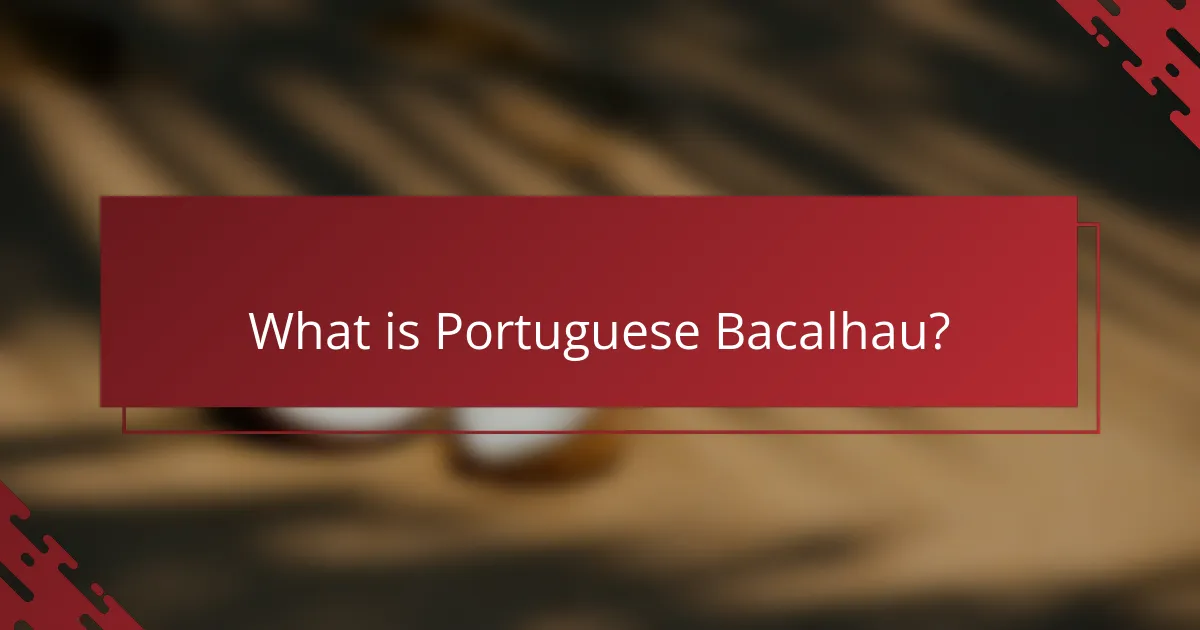Portuguese Bacalhau is a traditional salted and dried codfish that serves as a staple in Portuguese cuisine. Known for its versatility, Bacalhau is rehydrated through soaking in water, which prepares it for various cooking methods such as boiling, baking, frying, and grilling. The article explores traditional recipes that highlight Bacalhau, including Bacalhau à Brás, Bacalhau com Natas, and Bacalhau à Gomes de Sá, emphasizing popular flavor pairings like olive oil, garlic, and potatoes. Additionally, it discusses the historical significance of Bacalhau and its role in festive meals, particularly during Easter and Christmas.

What is Portuguese Bacalhau?
Portuguese Bacalhau is a traditional salted and dried codfish. It is a staple in Portuguese cuisine and is known for its versatility. Bacalhau is often soaked in water for several days to rehydrate before cooking. This process reduces its saltiness and prepares it for various dishes. The fish has a firm texture and a mild flavor, making it suitable for numerous recipes. Historical records indicate that bacalhau has been consumed in Portugal since the 15th century. Its popularity stems from its long shelf life and nutritional value. Bacalhau is often featured in festive meals, especially during Easter and Christmas.
How is Bacalhau traditionally prepared in Portugal?
Bacalhau is traditionally prepared in Portugal through various cooking methods. The most common preparation involves soaking the salted cod in water for 24 to 48 hours. This process rehydrates the fish and removes excess salt. After soaking, bacalhau can be boiled, grilled, baked, or fried.
Popular dishes include Bacalhau à Brás, where the fish is shredded and mixed with potatoes and eggs. Another favorite is Bacalhau com Natas, which features layers of cod and creamy sauce.
These traditional methods reflect Portugal’s deep culinary heritage. Bacalhau is often served during festive occasions, particularly at Christmas. The versatility of bacalhau allows for numerous regional variations across the country.
What are the key steps in the salting and drying process of Bacalhau?
The key steps in the salting and drying process of Bacalhau include selecting the fish, salting, and drying. First, high-quality codfish is chosen for the process. The fish is then thoroughly cleaned and salted. Salt is applied generously to preserve the fish and enhance flavor. After salting, the fish is left to cure for a specific duration. This curing period typically lasts from several days to weeks, depending on the desired saltiness. Once cured, the fish is rinsed to remove excess salt. Finally, the Bacalhau is dried, often in a cool, ventilated area, to achieve the desired texture and shelf life. This traditional method has been used for centuries, ensuring the fish remains edible for long periods.
Why is the preservation method significant in Portuguese cuisine?
The preservation method is significant in Portuguese cuisine because it enables the long-term storage of food, particularly fish. Salting and drying techniques have been used for centuries, especially for bacalhau (cod). This method allows for the fish to be preserved without refrigeration. It also enhances the flavor and texture of the fish, making it a staple in various traditional dishes. Historical records show that this practice dates back to the 15th century during the Age of Discovery. Portuguese sailors relied on preserved fish for sustenance during long voyages. The preservation method thus plays a crucial role in the cultural and culinary identity of Portugal.
What are the historical origins of Bacalhau in Portugal?
Bacalhau, or codfish, has deep historical roots in Portugal. Its origins trace back to the 15th century. Portuguese fishermen began to catch cod off the coasts of Newfoundland. The preservation method of salting was developed to extend its shelf life. This allowed cod to be transported back to Portugal. Bacalhau became a staple in Portuguese cuisine over the centuries. It is often referred to as “the faithful friend” due to its versatility. Today, it is featured in numerous traditional dishes. Bacalhau is integral to Portuguese culture and culinary identity.
How did Bacalhau become a staple in Portuguese households?
Bacalhau became a staple in Portuguese households due to its long shelf life and versatility. Historically, cod was preserved by salting and drying, making it an essential food source for sailors. This preservation method allowed for easy transport and storage, especially during long voyages. By the 15th century, cod fishing became prominent, particularly in Newfoundland. The Portuguese developed numerous recipes and cooking methods for bacalhau, integrating it into their culinary traditions. Today, it is said that there are over 365 ways to prepare bacalhau, reflecting its significance in Portuguese culture. Bacalhau is commonly served during festive occasions, further solidifying its status as a household staple.
What cultural significance does Bacalhau hold in Portuguese traditions?
Bacalhau, or salted cod, holds significant cultural importance in Portuguese traditions. It is often referred to as the “faithful friend” of the Portuguese. Bacalhau is a staple in Portuguese cuisine, especially during festive occasions. It is traditionally served on Christmas Eve as a symbol of abundance and celebration. The dish is associated with family gatherings and communal meals, reinforcing social bonds. Historical records indicate that bacalhau was introduced to Portugal in the 15th century. This fish became popular due to its long shelf life and versatility. Today, there are over 365 different recipes for bacalhau, one for each day of the year. This highlights its integral role in Portuguese culinary heritage.

What are the traditional cooking methods for Bacalhau?
Traditional cooking methods for Bacalhau include boiling, baking, frying, and grilling. Boiling is often used to rehydrate the salted cod before further preparation. Baking typically involves layering Bacalhau with potatoes, onions, and olives. Frying is common for dishes like Bacalhau à Brás, where shredded cod is mixed with potatoes and eggs. Grilling is another method, often used for whole fish served with simple seasonings. These methods have deep roots in Portuguese culinary traditions, reflecting the versatility of Bacalhau in various regional dishes.
How is Bacalhau commonly cooked in Portuguese households?
Bacalhau is commonly cooked in Portuguese households by boiling, baking, or frying. Boiling is often the first step to rehydrate the salted cod. After boiling, it may be baked with potatoes and onions. Another popular method is frying it in olive oil, often served with garlic and parsley. Bacalhau à Brás is a traditional dish where it is shredded and mixed with eggs and potatoes. Bacalhau com Natas features layers of cream and potatoes. These methods showcase the versatility of bacalhau in Portuguese cuisine.
What are the most popular recipes that feature Bacalhau?
The most popular recipes that feature Bacalhau include Bacalhau à Brás, Bacalhau com Natas, and Bacalhau à Gomes de Sá. Bacalhau à Brás is a dish made with shredded cod, onions, and potatoes, bound together with scrambled eggs. Bacalhau com Natas consists of cod baked with cream, potatoes, and onions, creating a rich and comforting meal. Bacalhau à Gomes de Sá features layers of cod, potatoes, onions, and olives, often garnished with hard-boiled eggs. These recipes showcase the versatility of Bacalhau in Portuguese cuisine.
How do cooking techniques vary across different regions of Portugal?
Cooking techniques in Portugal vary significantly by region. Each area showcases its unique culinary traditions and methods. In the north, techniques often include stewing and braising, reflecting the region’s hearty cuisine. The use of rich sauces and local ingredients is common in these dishes. Central Portugal emphasizes roasting and grilling, especially with meats and fish. This region also favors the use of olive oil and herbs. The Algarve, in the south, is known for its seafood preparation, often involving grilling or frying. Traditional methods like caldeirada, a fish stew, highlight local flavors. Additionally, the Azores and Madeira islands use techniques such as smoking and curing, influenced by their maritime culture. Overall, regional diversity in cooking techniques is a hallmark of Portuguese cuisine, shaped by local ingredients and cultural influences.
What are the unique characteristics of Bacalhau dishes?
Bacalhau dishes are characterized by their use of salted cod as the primary ingredient. This fish is traditionally preserved through salting, which enhances its flavor and extends its shelf life. Bacalhau is often rehydrated before cooking, allowing it to regain moisture and tenderness. The dishes typically incorporate a variety of ingredients, including potatoes, onions, and olives, which complement the cod’s rich taste.
Various cooking methods are employed, such as baking, frying, and stewing, showcasing the versatility of Bacalhau. Each method produces distinct textures and flavors, contributing to the dish’s complexity. Regional variations exist, with different areas of Portugal adding unique spices or preparation techniques. Bacalhau à Brás, for example, combines shredded cod with eggs and potatoes, creating a creamy texture.
The cultural significance of Bacalhau is evident in its presence during festive occasions and family gatherings. It is often considered a staple in Portuguese cuisine, symbolizing tradition and heritage.
How does the texture of Bacalhau change with different cooking methods?
The texture of Bacalhau changes significantly with different cooking methods. When boiled, Bacalhau becomes tender and flaky. This method retains moisture, resulting in a soft texture. Grilling Bacalhau gives it a firmer, slightly charred exterior while maintaining a moist interior. Baking creates a drier texture, enhancing its flavor but making it less tender. Frying Bacalhau results in a crispy outer layer, contrasting with a soft inside. Each method alters the moisture content and firmness of the fish. The choice of cooking method impacts the overall eating experience.
What flavors are typically highlighted in Bacalhau recipes?
Bacalhau recipes typically highlight flavors such as garlic, olive oil, and onions. These ingredients enhance the natural taste of the salted cod. Additionally, herbs like parsley and bay leaves are frequently used. They add freshness and depth to the dish. Spices such as black pepper and paprika can also be present. These spices contribute warmth and complexity. Accompaniments like potatoes and tomatoes further complement the flavors. Together, these ingredients create a rich and savory profile in Bacalhau dishes.

What are the best flavor pairings for Bacalhau?
The best flavor pairings for Bacalhau include olive oil, garlic, and onions. These ingredients enhance the natural saltiness of the cod. Potatoes are also a common pairing, providing a hearty texture. Other complementary flavors include tomatoes, bell peppers, and olives. Herbs such as parsley and cilantro add freshness. Additionally, lemon juice brightens the dish. Many traditional recipes incorporate these pairings to create balanced flavors. For instance, Bacalhau à Brás features potatoes and eggs, showcasing a classic combination.
Which ingredients complement the taste of Bacalhau?
Potatoes, onions, garlic, olives, and tomatoes complement the taste of Bacalhau. These ingredients enhance its flavor profile and provide a balanced dish. Potatoes add a creamy texture when cooked, often used in traditional Bacalhau recipes. Onions bring sweetness and depth, sautéed to create a savory base. Garlic provides aromatic richness, enhancing the overall taste. Olives introduce a briny contrast, which pairs well with the saltiness of Bacalhau. Tomatoes add acidity and freshness, brightening the dish. Collectively, these ingredients create a harmonious blend that elevates Bacalhau’s unique flavor.
How do herbs and spices enhance Bacalhau dishes?
Herbs and spices significantly enhance Bacalhau dishes by adding depth and complexity to the flavor profile. Common herbs like parsley and cilantro provide freshness that balances the saltiness of the cod. Spices such as paprika and black pepper contribute warmth and richness to the dish. Garlic, a frequent addition, intensifies the overall taste and aroma.
The use of herbs and spices can also complement the cooking method. For example, grilling Bacalhau with a marinade of olive oil, garlic, and herbs infuses the fish with robust flavors. Traditional recipes often highlight these ingredients, showcasing their importance in Portuguese cuisine.
Research indicates that the combination of herbs and spices can elevate the sensory experience of dishes, making them more appealing. This enhancement is crucial in traditional Bacalhau preparations, where flavor balance is key.
What are some traditional side dishes that pair well with Bacalhau?
Traditional side dishes that pair well with Bacalhau include boiled potatoes, sautéed greens, and chickpeas. Boiled potatoes are commonly served alongside Bacalhau dishes, providing a neutral flavor that complements the fish. Sautéed greens, such as kale or collard greens, add a vibrant color and nutritional value to the plate. Chickpeas are often included for their protein content and hearty texture. These side dishes are staples in Portuguese cuisine and enhance the overall dining experience with Bacalhau.
How do regional variations influence flavor pairings?
Regional variations significantly influence flavor pairings by reflecting local ingredients and culinary traditions. In Portugal, different regions utilize unique herbs, spices, and vegetables that impact how bacalhau is prepared and served. For instance, the northern regions often pair bacalhau with potatoes and olive oil, while the Algarve region favors tomatoes and peppers. These local ingredients create distinct flavor profiles that complement the salted cod. Additionally, historical trade routes and cultural exchanges have shaped these regional preferences. For example, the influence of Moorish cuisine in the south introduces flavors like cumin and coriander. This diversity in flavor pairings showcases the rich culinary landscape of Portugal and its adaptation to regional resources.
What unique ingredients are used in Bacalhau recipes across different regions?
Bacalhau recipes utilize unique ingredients based on regional preferences. In Portugal, ingredients like olives and potatoes are common. In the Azores, local cheese and herbs enhance the flavor. In Madeira, sweet peppers and onions are frequently used. The Algarve region often incorporates almonds and citrus. Each region adapts the dish to reflect local agricultural products. These variations showcase the versatility of Bacalhau in Portuguese cuisine.
How does local cuisine affect the flavor profile of Bacalhau dishes?
Local cuisine significantly influences the flavor profile of Bacalhau dishes. Regional ingredients and cooking techniques shape the taste. For instance, in the Algarve, the use of local olives and citrus enhances Bacalhau’s flavor. In Lisbon, the addition of tomatoes and peppers provides a different taste experience. Each region’s culinary traditions introduce unique spices and herbs. This creates a variety of Bacalhau preparations, such as Bacalhau à Brás or Bacalhau com Natas. The local seafood also complements the dish, adding freshness. Overall, local cuisine enriches Bacalhau, making it a versatile and celebrated dish across Portugal.

What are the common serving styles for Bacalhau?
Bacalhau is commonly served in various styles, reflecting Portuguese culinary traditions. One popular style is Bacalhau à Brás, which features shredded cod mixed with onions, potatoes, and eggs. Another common preparation is Bacalhau com Natas, where the cod is baked in a creamy sauce with potatoes. Bacalhau à Gomes de Sá is a traditional dish that combines cod with onions, olives, and hard-boiled eggs. Additionally, Bacalhau grelhado refers to grilled cod, often seasoned simply with olive oil and lemon. These serving styles highlight the versatility of Bacalhau in Portuguese cuisine.
How is Bacalhau typically served during festive occasions?
Bacalhau is typically served in various traditional dishes during festive occasions. It is often prepared as Bacalhau à Brás, which combines shredded cod with potatoes and eggs. Another popular dish is Bacalhau com Natas, featuring cod baked with cream and potatoes. Bacalhau à Gomes de Sá is also common, consisting of cod layered with onions, potatoes, and olives. These dishes are frequently accompanied by olives, boiled eggs, and vegetables. Festive meals often include Bacalhau as the centerpiece, especially during Christmas and Easter celebrations. The tradition of serving bacalhau stems from its historical significance in Portuguese culture.
What are the traditional presentation styles for Bacalhau dishes?
Traditional presentation styles for Bacalhau dishes include serving it in various forms such as fillets, stews, and casseroles. Bacalhau à Brás is commonly presented as a mixture of shredded cod, onions, and thinly sliced potatoes. Bacalhau com Natas features layers of cod baked with cream and potatoes, often garnished with parsley. Bacalhau à Gomes de Sá is typically served in a casserole style, showcasing layers of cod, onions, and olives. Bacalhau grelhado is usually presented grilled, often accompanied by vegetables. Each style emphasizes the distinct flavors and textures of the salted cod. These traditional presentations reflect the cultural heritage of Portuguese cuisine and its emphasis on communal dining.
How do serving styles differ between casual meals and celebrations?
Serving styles for casual meals and celebrations differ significantly. Casual meals often use informal serving methods, such as family-style or buffet. Guests serve themselves from shared dishes, promoting a relaxed atmosphere. In contrast, celebrations typically feature more formal serving styles. These may include plated service or a designated server. This approach emphasizes presentation and enhances the dining experience. Celebratory meals often showcase elaborate dishes, reflecting the importance of the occasion. According to culinary traditions, the serving style can influence the overall mood of the event. Casual meals prioritize comfort, while celebrations focus on elegance and formality.
What are some modern interpretations of Bacalhau serving styles?
Modern interpretations of Bacalhau serving styles include innovative presentations and flavor pairings. Chefs often create Bacalhau dishes with a fusion of global cuisines. For instance, Bacalhau is served in tacos, blending Portuguese and Mexican influences. Another approach is incorporating Asian flavors, such as miso or soy sauce, enhancing traditional recipes.
Some chefs use sous-vide techniques to cook Bacalhau, ensuring precise texture and flavor. Others present Bacalhau as a salad, combining it with fresh vegetables and citrus dressings. Additionally, Bacalhau is featured in gourmet bowls with grains and seasonal toppings.
These modern interpretations reflect a trend towards creativity while honoring the traditional essence of Bacalhau.
How are chefs innovating traditional Bacalhau recipes for contemporary dining?
Chefs are innovating traditional Bacalhau recipes by incorporating modern cooking techniques and global flavors. They experiment with sous-vide methods to enhance texture and moisture retention. Some chefs are blending Bacalhau with international ingredients, creating fusion dishes like Bacalhau tacos or sushi. Others focus on plant-based accompaniments, pairing Bacalhau with seasonal vegetables and herbs for a contemporary twist. Techniques such as smoking or grilling are being used to add depth to the flavor profile. These innovations cater to evolving diner preferences for diverse and unique culinary experiences. Chefs also emphasize presentation, using artistic plating to elevate the dish visually. This approach not only respects tradition but also makes Bacalhau relevant in today’s dining scene.
What fusion dishes incorporate Bacalhau in new and exciting ways?
Fusion dishes that incorporate Bacalhau include Bacalhau Tacos, blending Portuguese and Mexican cuisines. Another example is Bacalhau Sushi, which combines Japanese sushi techniques with traditional Bacalhau flavors. Bacalhau Pizza offers a unique Italian twist, featuring Bacalhau as a topping. Additionally, Bacalhau Curry merges Portuguese and Indian spices for a flavorful dish. These innovative combinations showcase Bacalhau’s versatility in global cuisine. Each dish highlights Bacalhau’s ability to adapt and enhance diverse culinary traditions.
What tips can enhance the enjoyment of Bacalhau dishes?
To enhance the enjoyment of Bacalhau dishes, consider using fresh ingredients and traditional seasonings. Fresh herbs like parsley and cilantro complement Bacalhau’s flavor. Citrus, particularly lemon, adds brightness to the dish. Pairing Bacalhau with potatoes can provide a hearty texture. Cooking methods such as grilling or baking can enhance its natural flavors. Additionally, serving with a drizzle of olive oil can elevate the taste. Historical preparation methods often include soaking the fish to reduce saltiness, which improves flavor balance. These tips are rooted in traditional Portuguese culinary practices.
Portuguese Bacalhau, a traditional salted and dried codfish, is a staple of Portuguese cuisine known for its versatility and long shelf life. The article explores the historical origins, traditional preparation methods, and cultural significance of Bacalhau, highlighting key cooking techniques and popular recipes. It also examines flavor pairings, regional variations, and modern interpretations, providing insights into how Bacalhau is served during festive occasions and casual meals. The comprehensive overview emphasizes the role of Bacalhau in Portuguese culinary heritage and its adaptability in contemporary dining.